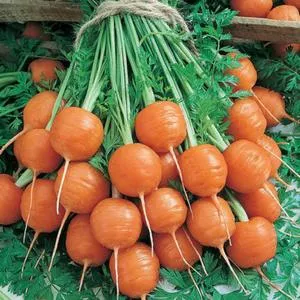Red Cored Chantenay Carrot
Daucus carota subsp. sativus
Price: $3.50
SKU: 3090011Choose a variant:
70 days - 'Red Cored Chantenay' plants are large, reaching about twenty inches tall, and produce roots that are five to 5½ inches in length, bright orange in color, stump-rooted in shape, and are tender and sweet tasting.
Chantenay-type carrots were developed and originally introduced in France in the 1830s. 'Red Cored Chantenay' is the result of continued selection by C. C. Morse & Company for "red" (dark-orange) colored roots and was introduced in 1930.[1] Here is what they had to say in their 1931 seed catalog:
Chantenay-type carrots were developed and originally introduced in France in the 1830s. 'Red Cored Chantenay' is the result of continued selection by C. C. Morse & Company for "red" (dark-orange) colored roots and was introduced in 1930.[1] Here is what they had to say in their 1931 seed catalog:
"The first time you pull this new carrot you will want to eat it then and there. The deep orange-red color and smooth symmetrical shape are combined with just the right size to make it irresistibly appetizing. Its beauty is not merely skin deep; it goes clear through to the very center and the interior is even more tempting than the outside. The yellow ring which is usually found around the core of carrots has been bred out of Red Cored Chantenay and in the breeding a sweeter, richer flavor has been acquired. This flavor alone is enough to establish its superiority and when combined with the crisp, tender quality and deep color of the flesh a new treat is furnished for those who appreciate the healthful and high nutriment value of carrots. On the inside back cover will be found an unretouched photograph [Ed. refer to image above] of this and other carrots in natural colors."[2]
Genetic Classification: Open Pollinated
Planting Instructions:
Loosen rich, well-drained soil to a depth of one foot, in a location that receives 6 to 8 hours of full sunlight per day.
Plant outdoors in spring as soon as the ground can be worked. Plant seeds ¼ inch deep, ½ inches apart in rows that are spaced 12 to 18 inches apart.
Keep moist until germination. Thin to 1 to 2 inches apart after the seedlings are 1½ inches tall.
Water as required and keep soil cultivated to control weeds.
Plant outdoors in spring as soon as the ground can be worked. Plant seeds ¼ inch deep, ½ inches apart in rows that are spaced 12 to 18 inches apart.
Keep moist until germination. Thin to 1 to 2 inches apart after the seedlings are 1½ inches tall.
Water as required and keep soil cultivated to control weeds.
References:
- "Morse's Seeds," C. C. Morse & Co., San Francisco, California, 1930 (see image of the catalog description above).
- "Ferry's Home Garden Catalogue," Ferry-Morse Seed Company, Detroit, Michigan & San Francisco, California, 1931.
- "Descriptions of Types of Principal American Varieties of Orange-Fleshed Carrots," USDA Miscellaneous Publication No. 361, May, 1940.
Customer Reviews:
Do you have experience with this one? 📝 📣 Write a review!
★★★★★ Awesome Carrots
By Steven (Crosby, Tx) on December 24, 2024
By Steven (Crosby, Tx) on December 24, 2024
Planted in october, harvesting in december. Good 10"-12" sweet carrots

★★★★☆ Not bad
By Amber Schooley on April 13, 2014
By Amber Schooley on April 13, 2014
The carrots in these are pretty good, but not nearly as good as the purple ones I got from here last year. Germination and growth were slightly better than the others, though.





